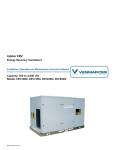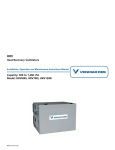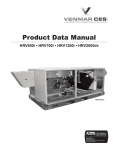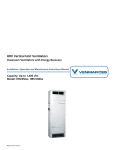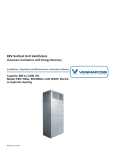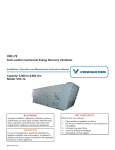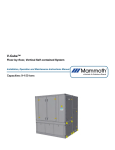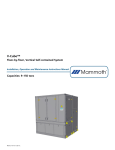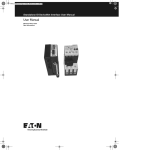Download Venmar 600 cfm Specifications
Transcript
ERV Energy Recovery Ventilators Installation, Operation and Maintenance Instructions Manual Capacity: 400 to 600 cfm Model: ERV500i/e ©2012 Venmar CES Inc. Table of Contents Nomenclature.......................................................................................................................................................................3 Safety Considerations..........................................................................................................................................................5 General Information............................................................................................................................................................5 Installation............................................................................................................................................................................5 Check Equipment...........................................................................................................................................................5 Mount Unit.....................................................................................................................................................................5 Make Duct Connections.................................................................................................................................................6 Rigging and Placing the Unit (ERV500e only)..............................................................................................................7 Install Hoods (ERV500e only).........................................................................................................................................7 Install Access Panel Handles..........................................................................................................................................7 Remove All Internal Packaging.....................................................................................................................................7 Systems Integration.......................................................................................................................................................8 Electrical Connections....................................................................................................................................................8 Start-up.................................................................................................................................................................................9 Controls..........................................................................................................................................................................9 Frost Control.................................................................................................................................................................10 Sequence of Operation................................................................................................................................................10 Airflow Balancing........................................................................................................................................................10 System Service....................................................................................................................................................................11 Quarterly Maintenance...............................................................................................................................................11 Annual Maintenance...................................................................................................................................................11 Testing and Replacement of the Damper Actuator...................................................................................................12 Motor and Blower Removal........................................................................................................................................12 Cassette Removal.........................................................................................................................................................13 Cassette Service............................................................................................................................................................13 Appendix A: Roofcurb Detail............................................................................................................................................15 Appendix B: Dimensional Drawing...................................................................................................................................16 Appendix C: Hood Installation and Rigging.....................................................................................................................18 Appendix D: Minimum Distance Requirements and Typical Installation.......................................................................19 Appendix E: Components..................................................................................................................................................20 Appendix F: Equipment Data............................................................................................................................................21 Appendix G: Terminal Control Diagrams..........................................................................................................................22 Appendix H: Troubleshooting...........................................................................................................................................26 Manufacturer reserves the right to discontinue or change specifications or designs without notice or obligation. vces-ERV-iom-1A – ERV500i/e 2 Nomenclature ERV500i Nomenclature (400–700 cfm) 1 2 3 4 5 6 1. FROST CONTROL D – Recirc defrost1 E – Exhaust only2 C – Non-defrost N – Non-defrost, no wall control compatibility 2. VOLTAGE/SPEED A – 120/1/60 3. INTERNAL PROTECTION 1 – 1” insulation, single wall 2 – 1” insulation, double wall 4. SENSOR CONTACTS W – Wheel rotation sensor3 X – No sensor 5. EXTERNAL FINISH S – Standard galvanized package W – White prepaint package 7 8 9 10 10. ENERGY RECOVERY 1 – Aluminum wheel, no purge 9. FREE COOLING S – Setpoint enthalpy controller D – Differential enthalpy controller T – Thermostat (dry bulb) X – No free cooling controller 8. FILTRATION S – Supply filter E – Exhaust filter B – Supply and exhaust filters X – No filtration 7. EXTERNAL DISCONNECT N – Non-fused disconnect switch4 X – No disconnect switch 6. OUTSIDE AIR DAMPER 1 – Insulated motorized 2 – Insulated spring return 3 – No damper Notes: 1 When ordering recirc defrost, you must order an outside air damper. Recirc defrost option includes recirculation dry contacts for unoccupied mode. 2 Outside air damper required. 3 Units ordered with the wheel rotation sensor option must include a frost control option other than ‘N’. 4 Non-fused disconnect switch is field installed. ©Venmar CES Inc. 2012. All rights reserved throughout the world. Illustrations cover the general appearance of Venmar CES products at the time of publication and Venmar CES reserves the right to make changes in design and construction at any time without notice. vces-ERV-iom-1A – ERV500i/e 3 ERV500e Nomenclature (400–700 cfm) 1 2 3 4 5 6 7 8 9 10 11 12 13 1. FROST CONTROL E – Exhaust only1 C – Non-defrost N – Non-defrost, no wall control compatibility 2. VOLTAGE/SPEED B – 208–120/1/60 - one-speed2 C – 230–120/1/60 - one-speed2 3. INTERNAL PROTECTION 1 – 1” insulation, single wall 2 – 1” insulation, double wall 4. SENSOR CONTACTS W – Wheel rotation sensor3 X – No contacts, no sensor 5. EXTERNAL FINISH G – Grey prepaint package 6. OUTSIDE AIR DAMPER 1 – Non-insulated motorized 2 – Insulated motorized 3 – Insulated spring return 4 – No damper 7. EXHAUST AIR DAMPER 1 – Backdraft (low leak) 2 – Non insulated motorized (low leak) 3 – Insulated motorized (low leak) 4 – No damper 14 14. ENERGY RECOVERY 1 – Aluminum wheel, no purge 13. FREE COOLING S – Setpoint enthalpy controller D – Differential enthalpy controller T – Thermostat (dry bulb) X – No free cooling controller 12. FILTRATION S – Supply filter E – Exhaust filter B – Supply and exhaust filters X – No filtration 11. RETURN AIR B – Bottom return air S – Side return air 10. SUPPLY DISCHARGE D – Down supply discharge E – End supply discharge 9. HOODS H – Intake/exhaust hoods X – No hoods5 8. EXTERNAL DISCONNECT N – Non fused disconnect switch4 X – No disconnect switch Notes: 1 Outside air damper required. 2 Requires a neutral wire with L1 and L2. 3 Units ordered with the wheel rotation sensor option must include a frost control option other than ‘N’. 4 Non fused disconnect switch is field installed. 5 Must order hoods when ordering dampers. vces-ERV-iom-1A – ERV500i/e 4 Safety Considerations Warning, Caution and Important notes appear throughout this manual in specific and appropriate locations to alert Installing Contractors and maintenance or service personnel of potential safety hazards, possible equipment damage or to alert personnel of special procedures or instructions that must be followed as outlined below. Warning ! Identifies an instruction which, if not followed, might cause serious personal injuries including possibility of death. Caution Identifies an instruction which, if not followed, might severely damage the unit, its components, the assembly or final installation. Hazards may exist within this equipment because it contains electrical and powerful moving components. Only qualified service personnel should install or service this equipment. Untrained personnel can perform basic maintenance such as maintaining filters. Observe precautions marked in literature and on labels attached to the unit. Follow all safety codes. ! Warning Disconnect the main power switches to the unit before performing service or maintenance. Electric shock can cause personal injury or death. Important Indicates supplementary information needed to fully complete an instruction or installation. General Information The ERV500i ventilator is intended for installation within a suspended ceiling space or mechanical room. The ERV500e ventilator is intended for installation on a rooftop with a factory supplied or field supplied roofcurb. These ventilators provide 100% outdoor air ventilation and provide energy recovery between the exhaust and supply airstreams. The Energy Recovery Ventilators (ERVs) use an enthalpy wheel for total energy recovery which provides superior efficiency in hot and humid climates. In addition, they provide excellent heat recovery in winter and transfer moisture from exhausted air to the outdoor air before supplying it to an occupied space. Installation Check Equipment Move the unit to its installation location and remove packaging. See Appendix F for unit weight and specifications. Inspect the exterior and interior of the equipment for damage. Ensure there is no damage to internal components such as fans, motors, dampers, enthalpy wheel, insulation, etc. File a claim with the shipping company if the unit is damaged. System Requirements Consult local building codes and the National Electrical Code for special installation requirements. Note additional requirements below and in the Start-up section. Mount Unit Interior Mount The unit should be installed to allow easy access for maintenance. Appendix B shows minimum clearance required between front access and any obstruction to allow for removal of components (fans, filters, enthalpy wheel). The vces-ERV-iom-1A – ERV500i/e front of the unit is defined in relation to the inlet ports and outlet ports on the unit. Port location and overall dimensions are shown in Appendix B. Unit components are shown in Appendix E. 5 In cold climates (−5°F [−20°C] design), the unit must be mounted in a dry area (not exceeding 30% RH) to avoid condensation on the exterior of the cabinet during winter operation. Alternatively, accommodation must be made for condensation on the cabinet exterior. Do not mount units in an area where exposure to hot chimneys, electrical panels or other hazards will occur. A mounting location close to an exterior partition will minimize the length of insulated ductwork required. Exhaust air to outside and inside air ducts must be insulated. Inlet and exhaust hoods should be separated by a minimum of 10 feet [3,048 mm] to avoid outside cross contamination. Ceiling Mount The unit must be mounted level and may be hung with threaded rod (field supplied) through the protruding frame at the base of the unit. Hole centers are shown in the overall dimensional drawings in Appendix B. Rubber or seismic vibration isolation may be required in some regions (field supplied and specified). Surface Mount Rooftop Mount (ERV500e Only) Care must be exercised in locating the roofcurb for the unit on the roof opening. The HVAC system should cross enough roof supports to safely distribute the weight of the system over the roof. For hole sizes of the units, see Appendix B. For more roofcurb information, see Appendix A. Remove roofcurb from packaging. Assemble and install accessory roofcurb in accordance with instructions shipped with the curb. See Appendix A for curb dimensions. Install cant strip, flashing and roof felt as per Appendix A. Important The gasketing of the unit to the roofcurb is critical for a water-tight seal. Install gasket with the roofcurb as shown in Appendix A. Improperly applied gasket can result in water leaks and poor unit performance. Ductwork must be attached to the roofcurb, not the unit. Consult with local authorities or your local building code for minimal intake hood height from the roof to determine the height of the roofcurb. See Appendix B for dimensions of the unit. The unit may be secured to a metal or wooden curb fastened to the floor. If securing the unit to the curb is required, fasteners and isolators may be used at the mounting points on the frame protruding from the unit (all mounting hardware is field supplied and specified). Make Duct Connections ERV500i Port locations for the indoor unit are labeled in Figure B1. An 18” [457 mm] long section of straight duct must be used immediately after the supply fan to achieve optimal fan performance. Transitions (field supplied) may be required to make connection with ductwork that is properly sized for minimum noise and pressure loss. Both duct connections to outside must be insulated to avoid condensation and heat loss. A continuous integral vapor barrier must be used over the duct insulation. Airflow rate balancing dampers are recommended for both supply and exhaust ducts to allow for adjustment of airflows as shown in Figure D1. Flexible connectors should be installed close to the unit in the duct leading to occupied spaces to minimize noise transmission. All ports have 1” [25 mm] flanges to facilitate duct connection. Ensure that fasteners used to make duct connection do not interfere with fans or dampers in the unit. vces-ERV-iom-1A – ERV500i/e Electric preheat, if used as frost control, must be installed in the intake from outside at a minimum distance from the unit port of 24” [610 mm]. ERV500e On vertical discharge units, secure all ducts to the roofcurb and building structure. Do not secure ductwork to the unit. For duct size requirements, see Appendix B. Insulate and weatherproof all external ductwork, joints and roof openings with counter flashing and mastic in accordance with applicable codes. Ductwork running through roof decks must comply with local fire codes. Ducts passing through unconditioned spaces must be insulated and covered with a vapor barrier. Flexible connectors should be installed close to the unit in the duct leading to occupied spaces to minimize noise transmission. 6 Rigging and Placing the Unit (ERV500e only) Inspect the exterior and interior of the equipment for damage. Ensure there is no damage to internal components such as fans, motors, dampers, enthalpy wheel, insulation and structures. File a claim with the shipping company if the unit is damaged. Important The hoods for these units are not installed from the factory and must be installed on site. They can be installed prior to rigging the unit or after the unit is installed. Hoods are shipped on top of the unit. When rigging the unit, ensure that the hoods are secured and are not damaged by the spreader bars. See Appendix C for hood installation and rigging information. Spreader bars are required to prevent damage to the roof flange. Rollers may be used to move the unit across a roof. Lifting holes are provided in the base rails as shown in Appendix C. For weights and overall dimensions, see Figure B2. Location Maintain clearance around and above the unit to provide proper airflow and service access. The fresh air intake hood must be positioned away from sources of contamination such as chimneys, exhaust vents, etc. Positioning the fresh air intake opposite to the prevailing winds will reduce entry of snow or moisture during periods of high winds. Caution All panels must be in place when rigging. Install Hoods (ERV500e only) Intake and exhaust hoods for these models are shipped separately from the unit. See Appendix C for hood installation information. A quick connect for the damper motors is provided to connect to the main body of the unit. Make sure that all screws are secured to maintain proper support and keep seals water-tight. Install Access Panel Handles Important Securing door fasteners too tightly has negative effects on the door gasket and should be avoided. Handles for access panels are provided but must be installed on site. Handles and fasteners are secured on the top of the unit. Remove from packaging and install according to Figure 1. Access panel Metal or polyamide handle #10 x ¾ Screw Figure 1: Access panel handles Remove All Internal Packaging Caution Remove all ERV wheel packaging prior to start-up. vces-ERV-iom-1A – ERV500i/e Remove access panels and remove all packaging from the unit. Note that there is packaging for the wheel support during shipping. Removal of all of this packaging is critical. 7 Systems Integration Forced Air System When the unit is installed in conjunction with a forced air system, the air handler and the network of ducts associated with it are used to distribute fresh air inside the building. If this type of system is used, the main fan of the air handler must operate continuously when the unit is on. Fan interlock can be connected in the unit control box to the integrated control board terminals J3-1 and J3-2. The controller makes relay contact between these terminals when the unit is operating, as shown in Figure 2. 2 1 1 J2 JU1G – Intermittent standy (IS) JU1F – Extended defrost COMM. N/C N/O J1 J4 1 2 3 6 4 9 7 Separate Systems Select locations for exhaust grilles and supply diffusers to provide effective ventilation and avoid short circuiting airflows through the space. Adjustable dampers should be provided at every grille and diffuser to make balancing of the system possible. Exterior Hoods 48644 power control board 3 Fresh air from the unit should be introduced into the return duct of the air handler at a point no less than 6 feet [1,829 mm] upstream of the air handler. The duct connection for stale air to the unit should be made on the return air duct at least 2 feet [610 mm] upstream of the fresh air duct connection. The outside air intake hood must be positioned away from sources of contamination. A screen with ¼” [6 mm] grid is recommended to prevent intake of debris and pests. The screen should be removable in cold climates where frost blockage may occur. JU1 + + + + + + + + + + + + + + ABCDEFG F F I OC OL Y R G B J3 Fan interlock contacts Figure 2: Fan interlock control board Electrical Connections ! Warning Unit cabinet must have an uninterrupted, unbroken electrical ground to minimize the possibility of personal injury if an electrical fault should occur. Failure to follow this warning could result in the Installer being liable for personal injury of others. All field wiring must comply with NEC and local requirements. In Canada, electrical connections must be in accordance with CSA C22.1 Canadian Electrical Code Part One. Table 1: ERV500 Power Supply ERV500i ERV500e Line voltage 120 230 Power Supply mca 9.4 11.1 These units may or may not have a factory installed disconnect switch. If disconnect is field supplied, provide a disconnect as per NEC. Use copper conductors only. mop 10 15 Field Connection A high voltage connection (shown in Figure 3) is located on the outside of the unit with knockout. A field installed vces-ERV-iom-1A – ERV500i/e 8 disconnect switch must use a liquid-tight connector between the disconnect switch and the outside panel of the unit eliminating any water penetration into the control box. A wiring diagram is located on the control box lid inside of the unit. The low voltage connection runs through the roofcurb and roof opening to the bottom panel. Low voltage remote wiring terminal is located inside the unit on the control box. Installer must provide wiring for the controls that may be supplied optionally. Rooftop unit (cutaway shown) ¾” locknut (as seen from inside the unit) ¾” x 1-3/8” liquid-tight connector ¾” locknut Line disconnect switch (cutaway shown) Figure 3: High voltage field connection Start-up Controls A low voltage remote control wiring interface is provided on the unit. The installer must provide wiring for the controls that may be supplied optionally. The optional wall controls require a four-wire LVT 24 gauge (or equivalent). This control is 12 VDC. Other terminals are 24 VAC or dry contact control. Terminals are available for the following controls: • • • • • • • Low-Com-High –– Makes dry contact for speed setting. Wall control –– Four-wire LVT 24 gauge minimum (12 VDC). Occupied timer/sensor –– Needs dry contact to operate. 24 VAC is required when timer is used. Do not use with Xtra wall control. Enthalpy control –– 24 VAC. Remote fan control –– Requires single pole, double throw switch. Low temperature control –– Makes dry contact. Wheel rotation sensor vces-ERV-iom-1A – ERV500i/e –– Makes dry contact. CO2 ventilation control –– Makes dry contact. • Unoccupied recirc contacts (ERV500i only) –– 24 VAC. • Smoke detector –– Makes dry contact. For more information on the controls available for the energy recovery ventilators, see the following Appendix G references: • • • • • • • • • • Wall Control Connection Occupied Timer/sensor Connection Enthalpy Control Remote Fan Control Low Temperature Control Wheel Rotation Sensor CO2 Ventilation Control Unoccupied Recirc Contacts (ERV500i only) Smoke Detector 9 Frost Control The unit functions are controlled by integrated unit controls including recirculation/exhaust only defrost (optional). In cold temperatures, frost control cycles will remove frost from the enthalpy wheel to maintain proper operation. This removal of frost occurs when a damper closes the outside air port and allows room air to circulate through the enthalpy wheel and back to the vented room. Each unit has different frost control requirements and the schedules are shown on the wiring diagrams located in the unit control box. Exhaust Only Supply fan is de-energized. There is no outdoor air ventilation for the duration of frost control. Enthalpy wheel maintains rotation. Recirculation (ERV500i Only) The exhaust fan is de-energized. There is no outdoor air ventilation for the duration of frost control. Enthalpy wheel continues to rotate. Sequence of Operation Before start-up, check the unit for obstructive packaging, objects near or in blowers, dampers, enthalpy wheel, etc. Once installation is complete, check all modes of operation to ensure that the unit is working properly. Close the doors and check for operation on Low and High using the dry contacts labeled Low-Com-High on the side of the unit. If there is a wall control, check the operation of all speed settings. • • Units Equipped with Frost Control When the unit is in defrost, unoccupied mode, or off, the ventilation damper will close. The ventilation damper will open during ventilation. • Important On initial power up, the unit will perform a system check and operate at high speed for five seconds. • Unit Checkpoints • • Power connected, no ventilation call – Both fans are off, frost control damper (if equipped) closes off fresh air from outside. Power connected, low speed call (if equipped) – Both fans on low speed, frost control damper (if equipped) • opens fresh air from outside and closes recirculation opening. If unit is single speed, it will come on that speed on a call for low or high. Power connected, high speed call – Both fans on high speed, frost control damper (if equipped) opens fresh air from outside and closes recirculation opening. If unit is single speed, it will come on the speed on a call for low or high. Power connected, occupied timer/sensor connection open (unoccupied mode) – Both fans are off, frost control damper (if equipped) closed off fresh air from outside. Power connected, enthalpy control contacts closed, unit ventilating – Wheel stops rotating, fans stay on set speed, frost control damper (if equipped) is open. Power connected, enthalpy control contacts closed, unit not in ventilation mode – Wheel does not rotate, fans come on low speed (if equipped), if unit is single speed, it will come on that speed on a call for low or high, frost control damper (if equipped) is open. Power connected, recirculation defrost (optional) is factory installed – Recirc contacts are closed, exhaust fan is de-energized, supply fan runs and recirculation damper opens (ERV500i only). Airflow Balancing For proper performance the unit must operate with equal supply and exhaust flow rates. Permanent or temporarily field supplied and installed flow measuring stations (FMS) and magnehelic gauges can be used to measure and compare supply flow with exhaust flow. Appendix D shows proper installation of the FMS in the “exhaust air from space” and “supply air to space” ducts for measuring exhaust and supply flows respectively. ferences in air density, especially when balancing during extreme cold outside conditions. Air density variations can effect the FMS by more than 15%. The FMS should be located downstream from straight sections of duct and not immediately after fans or obstructions that will cause turbulent flow. See Appendix D which illustrates minimum distances from fan, elbows or transitions for best operation. It is important to locate the FMS in the “warm side” ductwork as described above to minimize the effect of difvces-ERV-iom-1A – ERV500i/e 10 Flow control dampers should be installed downstream from the FMS so flow through the FMS is not disturbed. Dampers can then be adjusted to equalize flow rates in the ducts. Setting Flow Rate Flow rates should be balanced with units operating on high speed. A damper must be used to establish the minimum duct pressure required so fans do not operate in overload regions. Set the dampers to establish the minimum duct pressure required. Further adjust the dampers to reduce flow to the desired, balanced rate. Where space is limited in the outdoor air or exhaust air ducts, pressure drop readings can be taken across the enthalpy wheel rotor and extrapolated from Table 2. Heat recovery performance is tested in accordance to AHRI Standard 1060 and is accurate to within +/− 5% if there is no dirt buildup in the heat recovery wheel. Table 2: ERV500i/e Enthalpy Wheel Airflow vs. Velocity and Pressure Drop Airflow (cfm) Airflow performance can be measured using flow measuring stations (FMS) as described above or performing air flow measurements using ASHRAE suggested methods. Velocity (fpm) Pressure Drop (in. w.g.) 300 417 0.45 400 556 0.60 500 695 0.76 600 834 0.93 700 973 1.10 System Service Quarterly Maintenance ! Warning Disconnect the main power switch to the unit before performing service and maintenance procedures. Quarterly maintenance (every three months) should include: Air Filters placement may be required under extremely dirty operating conditions. For filter specifications, see Appendix F. Cassette Panels and Interior of Unit The foil faced insulation surfaces and cassette panels should be wiped clean with a soft cloth and mild cleaning solution. The standard medium efficiency filters are disposable and should be replaced every three months. More frequent re- Annual Maintenance Annual maintenance should include: Air Filters Replace medium efficiency filters. Rotor Interior of Unit Brush.seal Wash the foil faced insulation surfaces with a soft cloth and mild cleaning solution. Enthalpy Wheel No cleaning of the enthalpy wheel is required, it is selfcleaning due to the opposing airflows. If the enthalpy wheel needs to be cleaned, use low pressure air or a vacuum. Wash the cassette panels with a soft cloth and mild cleaning solution. Visually inspect the cassette brush seals (shown in Figure 4), perimeter seal and drive belt for proper operation. Figure 4: Brush seal Fans The blower wheels and fan housing should be checked for dirt build-up. If they are dirty, it will be necessary to remove the blower assembly to clean the dust out through the fan mouth. System Operation Check Verification of all control modes should be checked to ensure proper operation. Refer to Start-up Section. vces-ERV-iom-1A – ERV500i/e 11 Testing and Replacement of the Damper Actuator ! Warning Disconnect the main power switch to the unit before performing service and maintenance procedures. After disconnecting the power from the unit, determine if the actuator is defective. Disconnect the 24V power source. Connect the actuator directly to a 24V power source with an appropriate cable. If the damper operates correctly, the problem is either in the wiring connections or main circuit board. If the actuator does not work, it must be replaced. Loosen the nuts on the jack shaft clamp, remove the actuator. Tighten the clamp on the damper jack shaft. Test for proper operation. Motor and Blower Removal Exhaust After disconnecting the power from the unit, disconnect all the plug-in connectors on the left side of the control box. Figure 5: Disconnect plug-in connectors Remove the four Phillips head screws holding the control box cover. Using a ¼” nut driver, remove the four hex head screws holding the control box to the unit. Remove the control box to gain access to the exhaust blower assembly. To remove the exhaust blower, unscrew the two wing nuts used to fasten the blower assembly to the middle shelf in the unit. Rotate the blower assembly and slide it out of the unit. Figure 7: Remove exhaust blower Supply After disconnecting the power from the unit, disconnect the three-wire connector between the supply motor and control box. Figure 6: Remove control box cover Figure 8: Disconnect three-wire connector vces-ERV-iom-1A – ERV500i/e 12 Warning ! Disconnect the main power switch to the unit before performing service and maintenance procedures. To remove the supply blower, unscrew the four wing nuts used to fasten the blower assembly to the middle shelf of the unit. Slide the blower assembly out of the unit. Figure 9: Remove supply blower Cassette Removal After disconnecting the power from the unit, disconnect the two three-wire connectors located on the metal frame of the cassette assembly. Both connectors are positioned at the front of the cassette assembly, one connector located at the top right position and the other at the bottom left position on the cassette frame. Disconnect the threewire connector from the control box being used to supply power to the cassette motor. Important Use extreme care when removing or installing the cassette assembly. Damage to the cassette media may result in poor unit efficiency and may void the warranty. Figure 10: Remove cassette assembly Cassette Service Brush Seal Complete the following instructions to replace the brush seal on both sides of the cassette. On the belt side of the cassette, remove the two Phillips screws holding the air filter guide to the cassette assembly. Remove the additional Phillips screw holding the brush seal to the cassette assembly. On the motor side of the cassette, remove the three Phillips screws holding the brush seal to the cassette assembly. Figure 11: Remove screws holding brush seal to cassette assembly vces-ERV-iom-1A – ERV500i/e 13 ! Warning Disconnect the main power switch to the unit before performing service and maintenance procedures. Using a 7/16” nut driver, remove the four ¼” bolts holding the cassette beam to the cassette frame. The cassette beam can now be removed and placed aside to re-install later. Install the new brush seals so that the bristles come in contact with the cassette. Reverse the procedures above to re-install the brush seals and the air filter guide. Drive Belt To replace the cassette drive belt, the brush seal located on the drive belt side of the cassette must be removed. Complete the steps in the previous section for the removal of the brush seal prior to completing the following procedures. The cassette beam assembly must be removed to gain access to the cassette drive belt. To remove the cassette beam assembly, remove the three Phillips screws used to fasten the cassette beam cover. Figure 14: Remove cassette beam bolts Remove the outer half of the adjustable sheave (pulley). Using a 5/32” Allen key, loosen the set screw located on the outer half of the adjustable sheave. Remove the outer half of the adjustable sheave by turning it counterclockwise. This sheave piece is threaded and therefore it will take a few rotations to completely remove it. Once removed, slide the belt off the cassette. Figure 12: Remove cassette beam assembly Using a 1/8” Allen key, loosen the two set screws used to tighten the cassette bearing to the cassette shaft. The set screws are located in-line with the cassette shaft, between the cassette and the cassette beam. After loosening one set screw, it will be necessary to rotate the wheel a half turn to access the second set screw. Figure 15: Remove belt from cassette Install the new belt onto the cassette and adjustable sheave (pulley). Re-install the outer half of the adjustable sheave by rotating it clockwise onto the threaded shaft. This process will be used to tighten the belt around the perimeter of the cassette. Do not tighten the belt onto the cassette until the beam assembly has been reinstalled. Reverse the above procedures to re-assemble the cassette assembly. It will also be necessary to complete the steps in the previous sections that were used to install the cassette brush seal and the cassette. Figure 13: Loosen set screws vces-ERV-iom-1A – ERV500i/e 14 Appendix A: Roofcurb Detail SECTION A-A Unit 3/8” [10] gasket (supplied with curb) Wood nailer A A Supply air Return air Overhang: 3” [76] Unit baserail Counter flashing (field supplied) Roofing felt (field supplied) Cant strip (field supplied) Rigid insulation (optional) Roofing material (field supplied) 2.375” [60] 17.500” [445] 14.500” [368] 5.500” [140] 64.000” [1,626] 15.250” [387] 1.500” typ. [38] 61.000” [1,549] 15.000” [381] 1.500” typ. [38] Rigid insulation (styro) Wood nailer Note: Dimensions in [ ] are millimeters. Figure A1: ERV500e roofcurb vces-ERV-iom-1A – ERV500i/e 15 vces-ERV-iom-1A – ERV500i/e 2.750” [70] 4.500” [114] 5.250” [133] Supply air opening 4.000” [102] LEFT VIEW 5.750” [146] Return air opening Supply air 24.000” [610] Low voltage connection (leave 16” [406] in front for access) Electrical connection box 8.000” [203] Return air 8.000” [203] 14.000” [356] BOTTOM VIEW FRONT VIEW 58.000” [1,473] Supply fan, control box, filter, cassette access panel 52.000” [1,321] 14.000” [356] 1.500” [38] 54.000” [1,372] TOP VIEW 23.000” [584] Hanging mount hole Ø 0.625” [16] C Note: If the unit is to be hung, materials required to hang the unit will be supplied by others. 16.000” [406] A 27.750” [705] 56.000” [1,422] 2.000” [51] 19.5 43.0 63.5 190.0 C D TOTAL Note: Requires a minimum of 24.000” [610] clearance to open door and remove internal components. RIGHT VIEW 14.000” [356] Outdoor air opening 5.750” [146] 22.000” [559] 28.8 86.0 Kg 24.0 13.7 ERV500i LBS 53.0 30.5 PTS A B Exhaust air opening Recirculation defrost port (optional) Outdoor air Exhaust air D 9.375” [238] 23.000” [584] B 4.000” [102] 22.000” [559] 2.000” [51] 8.000” [203] 5.250” [133] 5.000” [127] Notes: Dimensions in [ ] are millimeters. Center of gravity Direction of airflow Appendix B: Dimensional Drawing Figure B1: ERV500i unit dimensions 16 Figure B2: ERV500e unit dimensions vces-ERV-iom-1A – ERV500i/e 17 17.843” [453] 7.831” [199] LEFT VIEW 24.000” [610] 23.000” [584] Exhaust air 7.100” [180] 19.981” [508] Field power supply 4.481” [114] A 6.776” [172] 24.000” [610] Exhaust air hood 15.500” [394] 27.000” [686] 6.100” [155] Exhaust air 12.380” [314] 3.810” [97] 10.257” [261] 4.983” [127] 5.310” [135] Air return bottom SECTION VIEW AA A B 14.000” [356] A 30.831” [783] RIGHT VIEW 6.047” [154] 5.150” [131] Air supply bottom 15.260” [388] 10.250” [260] 9.200” [234] 27.000” [686] 13.500” [343] End supply air 16.000” [406] BACK VIEW 6.500” [165] Connection Sizes 7/8” 1 1/8” 9.500” Side return [241] air 14.393” [366] A Low voltage knockout B Low voltage knockout Connection Table ERV500e Notes: Dimensions in [ ] are millimeters. Direction of airflow Note: Requires a minimum of 24.000” [610] clearance to remove internal components. 23.000” [584] 5.700” [145] 2.705” [69] 16.000” [406] Supply air 15.000” [381] FRONT VIEW Return air 68.000” [1,727] TOP VIEW 52.000” [1,321] Outdoor air hood Outdoor air Outdoor air 22.000” [559] 24.090” [612] 1.000” [25] 11.091” [282] Appendix C: Hood Installation and Rigging Detail A See Detail A Screw: #10 x 3/4 Detail B Male Black Female Female See Detail B Black Male White White Figure C1: ERV500e hood installation Spreader bars Note: Remove all packaging before beginning to rig the unit onto the installed roofcurb. Figure C2: ERV500e rigging vces-ERV-iom-1A – ERV500i/e 18 Appendix D: Minimum Distance Requirements and Typical Installation Exhaust air from space Min. 36” [914 mm] Flow measuring station (FMS) Balancing damper Flexible duct connection Supply air to space Min. 36” [914 mm] Min. 12” [305 mm] Exhaust air to outside Min. 36” [914 mm] Supply air from outside Figure D1: ERV500i minimum distance requirements Supply air Exhaust air Roofcurb Supply air Return air Figure D2: ERV500e typical installation vces-ERV-iom-1A – ERV500i/e 19 Appendix E: Components 1 2 5 10 7 11 3 6 Item 1 2 3 4 5 6 7 8 9 10 11 4 9 8 Description Supply blower Supply blower motor Exhaust blower Exhaust blower motor Control box Supply filter Exhaust filter Damper actuator Intake damper Enthalpy wheel Wiper seal Some unit components listed above are optional. Consult the unit nomenclature for standard and optional components. Figure E1: ERV500i unit components 17 13 11 1 2 10 14 4 19 3 5 7 6 9 8 15 12 16 18 19 1 2 3 Item 1 2 3 4 5 6 7 8 9 10 11 12 13 14 15 16 17 18 19 Description Housing Fan Fan motor Enthalpy wheel Wheel drive motor Wheel drive pulley Wheel drive belt Wheel perimeter seal Wheel wiper seal Damper actuator Damper intake Exhaust damper actuator Exhaust damper MEF supply filter set (two per set) MEF exhaust filter set (two per set) Oudoor air intake hood Exhaust air hood Aluminum mesh prefilter Control box Some unit components listed above are optional. Consult the unit nomenclature for standard and optional components. Figure E2: ERV500e unit components vces-ERV-iom-1A – ERV500i/e 20 Appendix F: Equipment Data Table F1: ERV500 Equipment Data ERV500i ERV500e Rated airflow (cfm) 559 cfm @ 0.5” w.g. 507 cfm @ 0.50” w.g. Shipping weight 320 lbs [145 kg] 320 lbs [145 kg] Shipping dimensions (L x W x H) 57.5” x 24.75” x 24” [1,461 x 629 x 610 mm] 68” x 27” x 23” [1,727 x 686 x 584 mm] Fans Impeller (forward centrifugal) Motor 8.5” diameter x 3.5” width [216 mm diameter x 89 mm width] ¼ hp supply and exhaust, two-speed on high 8.5” diameter x 3.5” width [216 mm diameter x 89 mm width] ¼ hp supply, ¾ hp exhaust, single-speed 10” x 20” x 2” disposable [254 x 508 x 51 mm disposable] 10” x 20” x 1” disposable [254 x 508 x 25 mm disposable] Supply and exhaust filters Quantity: 1 per airstream MEF vces-ERV-iom-1A – ERV500i/e 21 Appendix G: Terminal Control Diagrams Wall Control Connection Occupied Timer/sensor Connection Two types of remote wall controls are available: Occupancy control is achieved by connection to the terminal interface shown below. These terminals require a dry contact which could be provided by a number of types of controls such as a timer, light sensor, occupancy sensor, Building Management System or other. The unit will not operate unless these contacts are closed!! 1. Standard wall control with fan switch and dehumidistat control. 2. Xtra wall control with fan mode selection, dehumidistat control and maintenance indicator. The remote wall controls work with the integrated electronic controls within the unit to control ventilation sequences. Each wall control above has different features and requires four-wire connection to the unit as shown below. Without the wall control, fans can be operated with dry contacts or a switch as in Figure G5. The drawing below shows a factory installed jumper and programmable timer option. JUMPER (factory installed) NSB Timer OCCUPANCY CONTROL (field installed) CONTROL CONTACTS 1 BLACK 2 RED CONTROL CONTACTS 1 BLACK 2 RED GREEN 11 YELLOW 12 LOW 13 3 COMMON 14 4 HIGH 15 5 DIRTY FILTER INDICATOR 16 6 (+) 24 VAC (1.5A–24 VAC) 17 7 (ERV UNITS) 18 8 19 9 20 10 WALL CONTROL 1 1 GREEN BLACK 11 WALL CONTROL JUMPER 2 3 4 LOW OCCUPIED TIMER/ SENSOR 4 5 YELLOW RED Wall Control 3 JUMPER CONTROL CONTACTS 12 13 14 HIGH 15 DIRTY FILTER INDICATOR 16 (1.5A–24 VAC) 17 (−) 24 VAC (40 VA) 6 (+) 24 VAC 7 (ERV UNITS) 8 9 10 ENTHALPY (ERV UNITS) (RECIRC UNITS) WHEEL ALARM OPTION (24 VAC) UNOCC. RECIRC CONTACTS A FIELD WIRED TERMINALS B 18 19 20 CLASS 2 VOLTAGE NOTE: Connections are all dry contacts except wall control, wheel alarm contacts and 24 VAC power contacts. Use of 24 VAC circuit requires isolating contacts (ex. thermostat) to prevent interconnection of Class 2 outputs. Figure G1: Wall control connection Important All controls accessories (ex. night setback timer, CO2 controller, enthalpy controller, smoke detector or wheel rotation sensor) intended to provide a contact closure for occupancy control across terminals 3 and 4 cannot be used in conjunction with the Xtra wall control. If a wall control is required in addition to any of these options, only the standard wall control may be used. Without these options, a factory installed jumper across terminals 3 and 4 must be installed. vces-ERV-iom-1A – ERV500i/e 2 3 4 (+) 24 VAC 7 (ERV UNITS) 9 ENTHALPY 12 LOW OCCUPIED TIMER/ SENSOR 13 COMMON 14 HIGH 15 DIRTY FILTER INDICATOR 16 (1.5A–24 VAC) 17 (−) 24 VAC (40 VA) (ERV UNITS) (RECIRC UNITS) WHEEL ALARM OPTION (24 VAC) UNOCC. RECIRC CONTACTS A 11 5 (40 VA) 10 5 (−) 24 VAC 6 8 COMMON OCCUPIED TIMER/ SENSOR GREEN YELLOW WALL CONTROL M FIELD WIRED TERMINALS B CLASS 2 VOLTAGE ENTHALPY (ERV UNITS) (RECIRC UNITS) WHEEL ALARM OPTION (24 VAC) UNOCC. RECIRC CONTACTS FIELD WIRED TERMINALS A B 18 19 20 CLASS 2 VOLTAGE NOTE: Connections are all dry contacts except wall control, wheel alarm contacts and 24 VAC power contacts. NOTE: Connections are all dry contacts except wall control, wheel alarm contacts and 24 VAC power contacts. Use of 24 VAC circuit requires isolating contacts (ex. thermostat) to prevent interconnection of Class 2 outputs. Use of 24 VAC circuit requires isolating contacts (ex. thermostat) to prevent interconnection of Class 2 outputs. Figure G2: Occupied timer/sensor connection Important All controls accessories (ex. night setback timer, CO2 controller, enthalpy controller, smoke detector or wheel rotation sensor) intended to provide a contact closure for occupancy control across terminals 3 and 4 cannot be used in conjunction with the Xtra wall control. If a wall control is required in addition to any of these options, only the standard wall control may be used. Without these options, a factory installed jumper across terminals 3 and 4 must be installed. Enthalpy Control Energy Recovery Ventilators (ERVs) can be controlled by an enthalpy controller that switches between free cooling and AC unit cooling. When free cooling is possible, the ERV will ventilate without energy recovery (the enthalpy wheel stops) on a call for cooling. The ventilation rate is not affected. If the unit is not operating, enthalpy control contact will initiate low speed ventilation. The enthalpy control must be connected in conjunction with a cooling thermostat control to prevent free cooling from initiating in heating seasons as shown below. 22 CONTROL CONTACTS CONTROL CONTACTS 1 THERMOSTAT (FIELD SUPPLIED) R GREEN 11 1 BLACK 2 RED WALL CONTROL RED 2 3 OCCUPIED TIMER/ SENSOR 4 TO AC UNIT COIL (24 VAC) 5 12 LOW 13 COMMON 14 HIGH 15 DIRTY FILTER INDICATOR 16 (−) 24 VAC GREEN 11 YELLOW 12 LOW 13 COMMON 14 HIGH 15 DIRTY FILTER INDICATOR 16 (1.5A–24 VAC) 17 REMOTE FAN SWITCH WALL CONTROL YELLOW C JUMPER Y BLACK 3 4 OCCUPIED TIMER/ SENSOR LOW HIGH (40 VA) TO AC UNIT COIL (GND) 6 (+) 24 VAC 7 (ERV UNITS) 8 + − − A/ENT SENSOR LOW HI (RECIRC UNITS ) A 10 GND UNOCC. RECIRC CONTACTS (24 VAC) 24 VAC FIELD WIRED TERMNIALS B 20 R 1 JUMPER TO AC UNIT COIL (24 VAC) 3 4 GREEN OCCUPIED TIMER/ SENSOR 5 (−) 24 VAC 6 (+) 24 VAC TO AC UNIT COIL (GND) B R NO CM W NC 8 9 T675A TEMP. CONTROLLER 10 (ERV UNITS) 12 LOW 13 COMMON 14 HIGH 15 DIRTY FILTER INDICATOR 16 (1.5A–24 VAC) (ERV UNITS) (RECIRC UNITS ) (24 VAC) A UNOCC. RECIRC CONTACTS FIELD WIRED TERMNIALS B 17 A FIELD WIRED TERMINALS B 18 19 20 Low Temperature Control The fans of the ERV can be controlled using a setpoint low temperature controller. If the supply air discharge temperature falls below the setpoint on the low temperature controller, the contacts between R–W break, therefore, de-energizing the fans and closing the outside air damper. Important 18 19 20 CLASS 2 VOLTAGE Setpoint PN 1604130 (T675A) UNOCC. RECIRC CONTACTS Figure G5: Remote fan control YELLOW ENTHALPY WHEEL ALARM OPTION WHEEL ALARM OPTION (24 VAC) 11 (40 VA) 7 (RECIRC UNITS) Use of 24 VAC circuit requires isolating contacts (ex. thermostat) to prevent interconnection of Class 2 outputs. BLACK RED (ERV UNITS) CLASS 2 VOLTAGE WALL CONTROL 2 8 ENTHALPY Note: Not all units have two speeds. Single speed units will be activated with either Low-Com or High-Com connection. NOTE: Connections are all dry contacts except wall control, wheel alarm contacts and 24 VAC power contacts. CONTROL CONTACTS C 7 (ERV UNITS) 9 Figure G3: Setpoint/differential enthalpy control Y (+) 24 VAC 10 Use of 24 VAC circuit requires isolating contacts (ex. thermostat) to prevent interconnection of Class 2 outputs. THERMOSTAT (FIELD SUPPLIED) 6 19 NOTE: Connections are all dry contacts except wall control, wheel alarm contacts and 24 VAC power contacts. A/DIFF-ENT ENTHALPY CONTROL (−) 24 VAC 18 CLASS 2 VOLTAGE MOUNTED IN OUTDOOR AIRSTREAM Setpoint PN 500053119S (A/Diff-ENT) Differential PN 500053120S (A/Ent) MOUNTED IN RETURN AIRSTREAM (1.5A–24 VAC) (ERV UNITS) WHEEL ALARM OPTION 9 + ENTHALPY 5 (40 VA) 17 NOTE: Connections are all dry contacts except wall control, wheel alarm contacts and 24 VAC power contacts. Use of 24 VAC circuit requires isolating contacts (ex. thermostat) to prevent interconnection of Class 2 outputs. Figure G4: Thermostat (dry bulb) control Remote Fan Control Remote fan control can be achieved by connecting dry contact controls to the terminal interface at terminals labeled: Low-Com-High (not all units have two speeds). Placing a jumper across the Low and Com terminals will put the unit in low speed ventilation or placing a jumper across the High and Com terminals will put the unit into high speed. Do not jumper all three terminals together. These controls could also be the following: SPDT switch, dehumidistat, CO2 sensor, light sensor, heat sensor, timer, Building Management System, etc. Figure G5 represents a switch connected to the unit. An Xtra wall control cannot be used with a low temperature control. The remote bulb sensor must be placed downstream of the supply air fan discharge. CONTROL CONTACTS NOTE: 1. R–W breaks on temperature fall 2. Sensing bulb is placed in supply airstream after the energy exchanger 1 BLACK 2 RED GREEN 11 YELLOW 12 LOW 13 COMMON 14 HIGH 15 DIRTY FILTER INDICATOR 16 (1.5A–24 VAC) 17 WALL CONTROL R 3 B 4 W 5 OCCUPIED TIMER/ SENSOR (−) 24 VAC (40 VA) 6 (+) 24 VAC 7 (ERV UNITS) T675A SETPOINT CONTROL Field installed low temperature unit control 8 9 10 ENTHALPY (ERV UNITS) (RECIRC UNITS) WHEEL ALARM OPTION (24 VAC) UNOCC. RECIRC CONTACTS A FIELD WIRED TERMINALS B 18 19 20 CLASS 2 VOLTAGE NOTE: Connections are all dry contacts except wall control, wheel alarm contacts and 24 VAC power contacts. Caution Use of 24 VAC circuit requires isolating contacts (ex. thermostat) to prevent interconnection of Class 2 outputs. Do not use a wall control and remote fan switch at the same time. Damage to the unit may occur. Figure G6: Low temperature control vces-ERV-iom-1A – ERV500i/e 23 Wheel Rotation Sensor ERVs can be equipped with a wheel rotation sensor option. This option cannot be ordered for a non-defrost unit. This option cannot be used in conjunction with a digital wall control and must be ordered with a control board. With the wheel rotating, the wheel rotation sensor board activates the relay coil and closes the ‘NO’ (normally open) set of contacts across the occupied/timer sensor contacts (pin 3 and 4), allowing the unit to operate. If the wheel rotation stops (unless in an enthalpy state, defrost mode or unoccupied condition), the contacts will be open and cause the motors to shut down and the dampers (optional) to close. Important CONTROL CONTACTS 1 2 WRS BOARD RELAY 3 'NC' CONTACTS (normally closed – opens on wheel failure) J1 J2 DELAY 24 VAC LIGHT or INDICATOR (supplied by others) 4 5 6 (+) 24 VAC 7 (ERV UNITS) 24V = 24 VAC COM = COMMON SEN = SENSOR 8 9 CAUTION 120 VAC 13 COMMON 14 HIGH 15 DIRTY FILTER INDICATOR 16 (1.5A–24 VAC) 17 (ERV UNITS) (RECIRC UNITS) WHEEL ALARM OPTION (24 VAC) UNOCC. RECIRC CONTACTS A FIELD WIRED TERMINALS B 18 19 20 CLASS 2 VOLTAGE NOTE: Connections are all dry contacts except wall control, wheel alarm contacts and 24 VAC power contacts. Use of 24 VAC circuit requires isolating contacts (ex. thermostat) to prevent interconnection of Class 2 outputs. CO2 Ventilation Control ERVs can be controlled by a CO2 controller that can be connected to fan control Low-Com-High (not all units have two speeds). As the CO2 levels exceed acceptable limits, the dry contact across High-Com is closed, raising high speed fan ventilation. 1 BLACK CO2 SENSOR 2 RED GREEN 11 YELLOW 12 LOW 13 WALL CONTROL NC 8 7 6 FACTORY MOUNTED JUMPER RELAY COM 3 4 OCCUPIED TIMER/ SENSOR COMMON 14 HIGH 15 DIRTY FILTER INDICATOR 16 (1.5A–24 VAC) 17 5 NC NO 4 3 5 (−) 24 VAC 2 (40 VA) COM SEN ALA = RELAY ON (24 VAC LIGHT, MAX. 1 AMP) DIS = ROTATION DETECTOR DISABLE (24 VAC) VEN = VENTILATION MODE (DISABLE WRS) (24 VAC) VEN ALA DIS ENTHALPY CONTROL CONTACTS NO 24 COM SEN LOW (−) 24 VAC 10 DEF+ DEF− NO = NORMALLY OPEN NC = NORMALLY CLOSED COM = COMMON NO COM NC OCCUPIED TIMER/ SENSOR (40 VA) CAUTION 120 VAC NO COM NC 24V COM SEN VEN ALA DIS 12 Figure G8: Wheel rotation alarm The wheel rotation sensor printed circuit board has 120 VAC wired to two terminals. Improper wiring or handling of the circuit board could either damage the board, the unit or cause personal injury. 2 YELLOW RED 3 A set of 24 VAC wheel alarm contacts are available on the terminals to power a light or indicator. The drawing below shows the wiring necessary to power the 24 VAC light or indicator. LED 1 11 WALL CONTROL If the wheel rotation sensor board shuts the unit down, the only procedure to re-start the unit is to turn the power off and then back on again. Caution GREEN BLACK 6 (+) 24 VAC 7 (ERV UNITS) 8 9 DEF+ = DEFROST MODE (DISABLE WRS) (120 VAC) DEF- = DEFROST MODE (DISABLE WRS) (120 VAC) 10 DEF+ DEF- ENTHALPY (ERV UNITS) (RECIRC UNITS) WHEEL ALARM OPTION (24 VAC) UNOCC. RECIRC CONTACTS A FIELD WIRED TERMINALS B 18 1 2 1 AC GROUND AC INPUT 19 20 Note 1: Terminal 5 on CO2 sensor used only with two-speed units. Note 2: Terminal 7 and 8 on CO2 sensor used only with blower VFDs. CLASS 2 VOLTAGE DELAY J1 & J2 = DETECTION DELAY J1 J1 J2 * J2 X X X X DELAY 1 min. 2 min. 4 min. 8 min. SENSOR MAGNET NOTE: Connections are all dry contacts except wall control, wheel alarm contacts and 24 VAC power contacts. Use of 24 VAC circuit requires isolating contacts (ex. thermostat) to prevent interconnection of Class 2 outputs. NORMAL OPERATION – LOW SPEED CO2 LEVELS EXCEED SETPOINT – HIGH SPEED *default LED 1 2 3 1 = RELAY ON (RED) 2 = POWER ON (GREEN) 3 = SENSOR DETECTION INDICATOR (YELLOW) Figure G7: Wheel rotation sensor board vces-ERV-iom-1A – ERV500i/e Figure G9: CO2 ventilation control 24 Unoccupied Recirc Contacts (ERV500i only) On recirc defrost units, an unoccupied recirc control can be achieved by connection to the terminal interface shown below. These terminals require a 24 VAC signal which could be provided by a timer, thermostat or other. Closure of these terminals will cause the unit to go into a recirc mode where the supply fan runs on high speed and the exhaust fan stops. an alarm condition is activated. By connecting the occupied timer/sensor contacts to the NC alarm auxiliary contacts on the duct sensor, an alarm condition will open the auxiliary contact and stop operation of the ERV. 1 2 24V Important Although these contacts are intended for use during unoccupied periods, they are still active during an occupied condition. Therefore, the 24 VAC signal should be applied such that it is disabled during occupied periods, preventing the unit from going into a recirc condition unnecessarily. 15 GREEN 11 3 4 5 12 OCCUPIED TIMER/ SENSOR LOW 13 COMMON 14 HIGH 15 (−) 24 VAC 18 19 C. N.O. N.O. 20 GRN. TROUBLE CONTACTS CLOSED IN ALARM AND STANDBY. CONTACTS OPEN WHILE DETECTOR HEAD OR POWER IS REMOVED, AND DURING RESET. OPEN CONTACTS SIGNAL TROUBLE CONDITION TO PANEL. 5 (+) ALARM SIGNAL 1 COMMON 6 FIELD INSTALLED JUMPER 10 3 POWER (D) AUX POWER 7 (+) 24 VAC 7 (ERV UNITS) 8 9 10 ENTHALPY TROUBLE CONTACT RATING 0.3A @ 32 VAC/DC TROUBLE CONTACTS CONTROL CONTACTS 1 GREEN 11 YELLOW 12 LOW 13 COMMON 14 HIGH 15 DIRTY FILTER INDICATOR 16 (1.5A–24 VAC) 17 BLACK WALL CONTROL DIRTY FILTER INDICATOR 16 2 (1.5A–24 VAC) 17 3 (ERV UNITS) (RECIRC UNITS) WHEEL ALARM OPTION (24 VAC) UNOCC. RECIRC CONTACTS A ALARM AUXILIARY CONTACT RATINGS 10A @ 30 VDC 10A @ 250 VAC (0.75 POWER FACTOR) 240VA @ 240 VAC (0.4 POWER FACTOR) 1/8 HP @ 120 VAC 1/4 HP @ 240 VAC 500mA MINIMUM @ 24 VDC NOT INTENDED FOR CONNECTION TO CONTROL PANELS. TROUBLE CONTACTS CLOSED IN STANDBY AND ALARM. CONTACTS OPEN WHILE DETECTOR HEAD OR POWER IS REMOVED, AND DURING RESET. OPEN CONTACTS EXTINGUISH OPTIONAL APA451 GREEN POWER LED TO INDICATE TROUBLE CONDITION. (+) AUX POWER 11 POWER INPUTS ACCEPT 24 VDC, 24 VAC 50–60 HZ, 120 VAC 50–60 HZ, OR 220/240 VAC 50–60 HZ. CONNECT POWER SOURCE TO APPROPRIATE TERMINALS OF EACH DETECTOR. ALARM INITIATION CONTACT RATING 2.0A @ 30 VAC/DC (0.6 POWER FACTOR) 9 N.O. (40 VA) 6 N.C. ALARM INITIATION CONTACTS 2 ALARM YELLOW RED C. 8 WALL CONTROL 2 17 ALARM AUXILIARY CONTACTS SHOWN IN STANDBY. CONTACTS TRANSFER DURING ALARM AS INDICATED BY THE ARROWS. RED BLACK 120 VAC 220/240 VAC ALARM AUXILIARY CONTACTS FOR FAN SHUTDOWN, ETC. 16 N.C. CONTROL CONTACTS 1 AVAILABLE POWER INPUTS 12 13 14 FIELD WIRED TERMINALS B 18 19 4 24 VAC required 20 5 Note: Unoccupied recirculation is available on units with recirculation defrost option only. Use of 24 VAC circuit requires isolating contacts (ex. thermostat) to prevent interconnection of Class 2 outputs. OCCUPIED TIMER/ SENSOR (−) 24 VAC (40 VA) 6 (+) 24 VAC 7 (ERV UNITS) CLASS 2 VOLTAGE NOTE: Connections are all dry contacts except wall control, wheel alarm contacts and 24 VAC power contacts. RED 8 9 10 ENTHALPY (ERV UNITS) (RECIRC UNITS) WHEEL ALARM OPTION (24 VAC) UNOCC. RECIRC CONTACTS A FIELD WIRED TERMINALS B 18 19 20 CLASS 2 VOLTAGE Figure G10: Unoccupied recirc contacts NOTE: Connections are all dry contacts except wall control, wheel alarm contacts and 24 VAC power contacts. Smoke Detector Use of 24 VAC circuit requires isolating contacts (ex. thermostat) to prevent interconnection of Class 2 outputs. Locate in a normally occupied area of premises. Recommended for compliance to NFPA-90A and IMC code 606. ERVs can be equipped with a duct mount smoke detector which will monitor the air when passing through the duct system into the ERV. When sufficient smoke is detected, vces-ERV-iom-1A – ERV500i/e Figure G11: Smoke detector 25 Appendix H: Troubleshooting Table H1: ERV500i/e Troubleshooting Problem Unit will not turn on. Unit will not turn off. Cause Solution External wiring not connected. Check external wiring. Internal wiring not making contact. Check the wiring in the control box. Occupied/unoccupied control circuit is open. Close circuit. Check if high or low speed control contacts are closed on the terminal strip. Check filters and enthalpy wheel for blockage. Check balance of airflow. Install post heat module. Remove the motor/blower assembly. External terminal strip wiring. Air from supply diffusers Imbalance of supply and exhaust air. too cold. Unit makes an annoying Blower wheel out of alignment. Adjust blower wheel. noise. Enthalpy wheel brush seal not functioning properly. Check for proper seal operation. Check unit circuit breaker. Check two-wire service Electrical supply interrupted. connector on motor. Check capacitor connections. Check motor operaDrive motor capacitor. tion with new capacitor. Drive motor failure. Check the drive motor. Enthalpy wheel not running. Drive motor relay in control box. Drive belt. Drive pulley. Free cooling contact closed. Fan motor failure. Open contact on external terminal block of unit. Check unit circuit breaker. Check three-wire service connector on each motor. Check capacitor connections. Check motor operation with a new capacitor. Check fan motor. Fan motor relay in control box. Check relay wiring. Check relay operation. Electrical supply interrupted. Motor and blower not functioning. vces-ERV-iom-1A – ERV500i/e Check relay wiring. Check relay operation. Check for drive belt derailment off of drive pulley or failure. Check for securely fastened pulley on motor shaft. Fan motor capacitor. 26 [email protected] www.venmarces.com Venmar CES Inc. has a policy of continuous improvement and reserves the right to change design and specifications without notice. ©2012 Venmar CES Inc. Vces-ERV-IOM-1A (PN 204279) April 2013



























